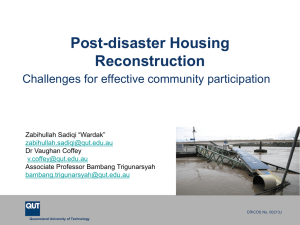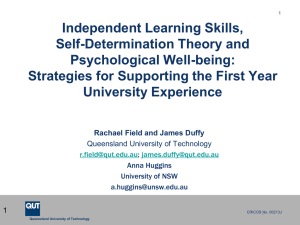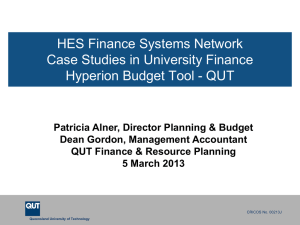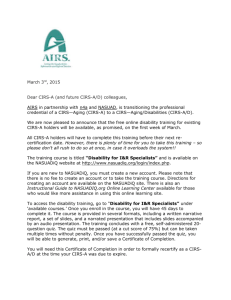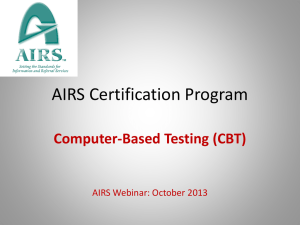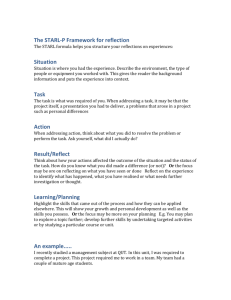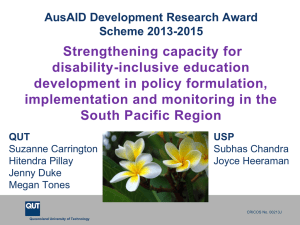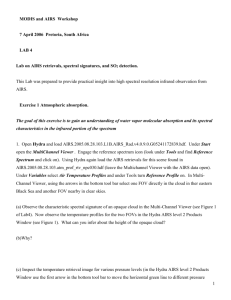Resource Log template (Word DOC, 312KB) - AIRS
advertisement
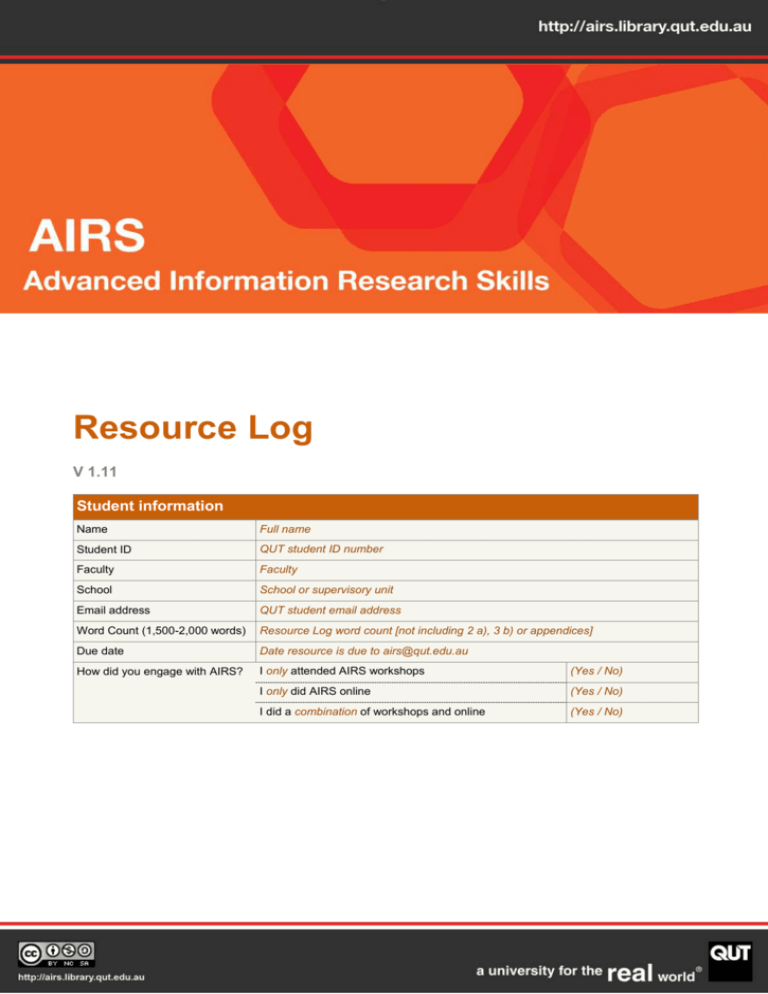
Resource Log V 1.11 Student information Name Full name Student ID QUT student ID number Faculty Faculty School School or supervisory unit Email address QUT student email address Word Count (1,500-2,000 words) Resource Log word count [not including 2 a), 3 b) or appendices] Due date Date resource is due to airs@qut.edu.au How did you engage with AIRS? I only attended AIRS workshops (Yes / No) I only did AIRS online (Yes / No) I did a combination of workshops and online (Yes / No) Resource log (100 pts) 1. Your research strategy (200-400 words, 10 marks) a) Write a research question for your area of research applying the 6 properties [see Module 1. Engage] b) Identify your theoretical construct/s and their recognisability. List your theoretical construct/s (concepts) and explain why you used these terms in your research question (E.g. I have used this term because authority x and y in my field…/the subject heading used in database z…etc.) c) Explain how your research question addresses at least three of the remaining four properties. Such as: Transcend the data: List the different methodologies and/or data that could be used to answer your research question. There are many ways to answer your research question Significance: Justify the significance of answering your research question Capacity to surprise: Explain how researching your question may produce surprising new ideas or new relationships between existing ideas Robustness: Ensure your research question will lead to complex results (cannot be answered with a ‘yes’ or a ‘no’) 2. Your search strategy (300-600 words, 30 marks) a) List the key concepts and the synonyms or related terms for your research question. [Module 4 Specialise] Key concept/word/phrase Synonyms/related terms Key concept/word/phrase Synonyms/related terms Additional Key concept/word/phrases Extra Synonyms/related terms IFN001 AIRS: Resource log CRICOS No. 00213J 1 b) Select three databases highly relevant to your research. List at least three search statements per database using at least five search techniques (such as Boolean, proximity, field or phrase searching, limiting, truncation and any other functionality). [See Module 2. Engage and Module 4. Specialise] Database 1 name List your search statements demonstrating search techniques Database 2 name List your search statements demonstrating search techniques Database 3 name List your search statements demonstrating search techniques Database 1 strengths Database 2 strengths Database 3 strengths Database 1 limitations Database 2 limitations Database 3 limitations IFN001 AIRS: Resource log CRICOS No. 00213J 2 3. Recording and organising your information (200-300 words, 10 marks) a) Describe and evaluate a bibliographic management software application that might be useful to you for your research? [See Module 7.2 Bibliographic management] Name of bibliographic management software Advantages of this software b) Limitations of this software Identify areas of literature relevant to answering your research question, and list the categories you will use to code and organise your literature. E.g. Area: Knowledge management – Code: KM [See Modules 1.2 The six properties in detail 2.1 The search process, and 7.3 Coding the literature] Area of literature Code Area of literature Code Area of literature Code Additional area/s of literature Additional Code/s c) Describe method/s you might use to i) make and ii) organise your notes to access and use your ideas and research findings. [See Module 7.4 Keeping useful notes] E.g. concept mapping, references, codes; document folders, bibliographic software IFN001 AIRS: Resource log CRICOS No. 00213J 3 4. Data management (200-400 words, 10 marks) a) Describe your data. i) What is your data, include description of the format and scope of your research data and ii) how will the data answer your research question? [See Module 1.2 The six properties in detail and Module 8. Manage] E.g.: literature, facts, observations, images, computer program results, calculations, recordings, survey results, interviews, measurements or experiences b) Outline your plans to securely store and back-up your data E.g. QUT/Faculty network drive, external hard drive, PC/Laptop, cloud, database, repository c) Discuss three types of contextual information (metadata) that help to make data more discoverable and useable E.g. Types of metadata include descriptive, rights etc. d) Discuss the administrative, commercial, legal and/or ethical considerations around storing and sharing research data E.g. accurate description of data, file format, data structures, storage location, etc. Documenting conditions such as: ownership, copyright, re-use licence conditions. Also privacy and access control considerations. e) Identify how long your data is legally required to be retained after completion of your research project/thesis. Refer to the Guidelines for the Management of Research Data at QUT and provide your reasoning. [See Module 8.2 Legal Issues] Consult the relevant section in the ‘Guidelines for the Management of Research Data at QUT’. IFN001 AIRS: Resource log CRICOS No. 00213J 4 5. Sustain (50-100 words, 5 marks) a) List one journal Table of Contents alert or a keyword search alert you have set up and explain why you chose this particular journal or search alert. [See Module 5 Sustain] Journal name or search alert statement List the database name or publisher website Why did you choose this particular journal or search alert? Explain the significance of the journal/database in your field and to your research. b) Identify a conference you would like to attend and explain why it relates to your research and/or the various ways in which it will help your networking opportunities. [See Module 9.1. Collaborating] I would like to attend... [conference] because... IFN001 AIRS: Resource log CRICOS No. 00213J 5 6. Publish (100-200 words, 5 marks) a) Name one scholarly journal in which you would like to publish and justify your choice in terms of accessibility of information, impact factor and appropriateness to your research area. [See Modules 1. Engage; 2. Search; 10. Publish and 11. Impact] Journal name... and 1-3 sentences summarising why (e.g.: impact factor, relevance to your research, connection to career goals, etc.). b) Write i) a very short proposal for a journal article, and ii) describe how your research and proposal address the journal’s specific guidelines for authors. [See Modules 1. Engage and Module 10. Publish] Summarise the component of research you would be writing about and how you will align it to the author guidelines for that journal. Clearly apply the author guidelines in your answer. IFN001 AIRS: Resource log CRICOS No. 00213J 6 7. Research impact (30 marks) Complete the table below. i) ii) iii) At the top of the table, name a selected referencing style appropriate to your discipline In the Reference column, list 10 highly relevant references accurate in the identified referencing style In the Impact analysis column, next to each reference, document the evidence of impact comprehensively. To document comprehensively, use multiple measures of evidence, (e.g.: citation counts, journal impact factor, h index, alt-metrics, reviews, etc.), from each of the multiple citation tools selected (Scopus, Web of Science, Hazing’s Publish or Perish, Google Scholar, WorldCat, Libraries Australia, Altmetrics, reviews etc...) as relevant for a reference. [See Module 1. Engage, Module 2. Basic Search, Module 3. Retrieve, Module 4. Specialise, Module 11. Impact] (See: http://libguides.library.qut.edu.au/databases/citation) i) Name of the referencing style used: ii) Reference iii) Impact analysis 1 2 3 4 5 6 7 8 9 10 IFN001 AIRS: Resource log CRICOS No. 00213J 7 Appendix A: Additional resources (0pts – optional) Record resources to investigate of relevance to your research (e.g.: key journals, key databases, websites, data sources etc.) Key journals Web resources Databases Library subscriptions & open access Theses Trove – Library of Australia ProQuest Dissertations Ethos – British Library Multi-disciplinary tools Google | Google Scholar QUT Library Quick Find Other resources Conferences, government information... Library catalogues Libraries Australia Data sources Worldcat British Library IFN001 AIRS: Resource log CRICOS No. 00213J 1 Appendix B: Research question areas of literature mind/concept map (0pts - Optional) Mind Mapping: Mind mapping : your personal guide to exploring creativity and problem-solving http://libcat.library.qut.edu.au/record=b1764439~S8 IFN001 AIRS: Resource log CRICOS No. 00213J Instructions Download the AIRS Assessment documents. Engage with the content as available in online modules, learning resources and campus workshops and plan and take the time to do the work. Complete the answers according to the question requirements of the assessment template and note the answer prompts. Make sure the answer reflects the marking criteria in the Criteria Sheet for the grade you are aiming for. Word limit (excluding the appendices) must be between 1,500-2,000 words Submit the work as a single Word or PDF file by email to airs@qut.edu.au Please use the filenaming convention: AIRS_Familyname_Personalname_dd-mm-yyyy, where the date is the actual date of submission. Please contact your Liaison Librarian by email or for consultation by appointment for discipline specific questions or clarification of requirements for particular questions. Submitted Resource Logs will be returned to enrolled IFN001 students within one month of submission. IFN001 AIRS: Resource log CRICOS No. 00213J
